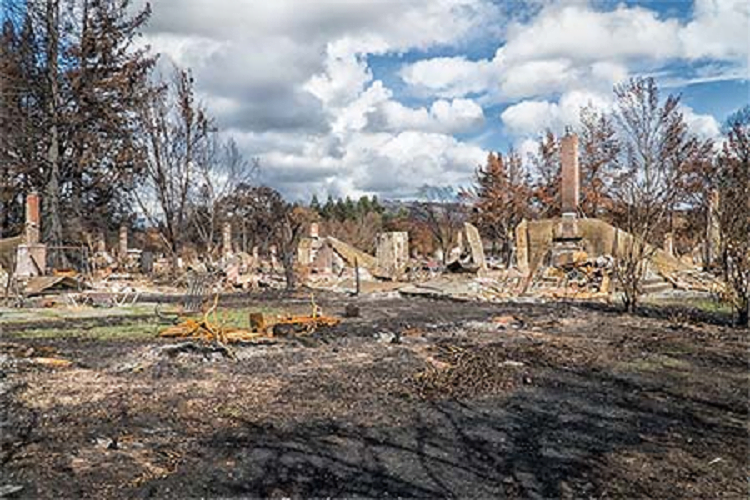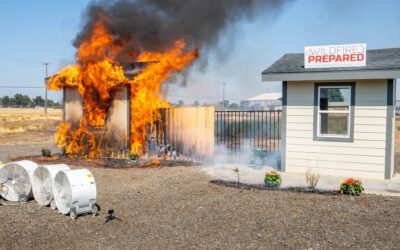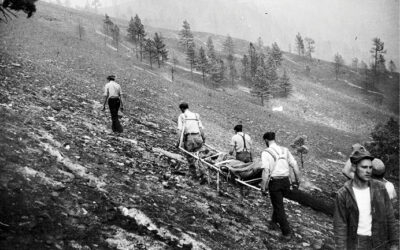Several factors usually play a role in whether a home will survive a wildland urban interface fire

United States Fire Administration
Researchers at the National Institute for Standards and Technology (NIST) are studying the complex fire behavior that occurs in the WUI and translating their findings into actionable steps that communities can take to reduce wildfire-related loss.
What they have found so far is that it is important to emphasize to community residents that there is not just one individual factor that can determine whether a home survives a wildfire; it is the relationship between everything on the landscape surrounding the home that can make a difference in whether a home survives or not.
Key WUI fire behavior influences
Weather and terrain
Wildfires, especially those that impact WUI communities, are driven by multiple factors interacting together that can determine the fire’s intensity and severity, including topography, wind, drought, relative humidity, and the condition and type of local vegetation. The behavior of larger wildfires can additionally be influenced by the weather systems they create, such as fire whirls and pyrocumulonimbus clouds.
Building materials and property layout
Home survivability can be influenced by their construction materials, proximity to other structures and how these neighboring structures are maintained. Overall layout of the property, including landscape design and if materials are stored within proximity of buildings, can also have an impact.
The NIST research approach
The NIST team looks at a piece of property as the sum of the whole: individual components are evaluated based on their combined influence on fire spread. To understand how components interact to influence WUI fire home survivability, researchers conduct in-depth post fire reconstructions of WUI fire events to:
Document fire behavior and defensive actions.
Identify conditions that can impact life safety of civilians.
Document structure ignition vulnerabilities.
Firefighters provide important data to NIST about how incidents develop and how homes ignite. This information helps identify ways to improve civilian and firefighter safety. Researchers build upon this knowledge with data on different construction materials and designs, resulting in technical knowledge that can be used to mitigate the risk of structural ignitions during a wildfire.
Examples of NIST-identified vulnerabilities
Fences
Post-fire research from NIST after the 2012 Waldo Canyon Fire showed that fence ignitions did contribute to home destruction.
New NIST research about fence ignitions shows how the interrelated parts of the fence can increase the ignition potential of the fence as well as contribute to the intensity at which the fencing material burns. It shows, for example, that two fences built parallel to each other will ignite and burn more readily and with far greater intensity than a single fence panel installation, which if near to or attached to the home, can cause home ignition.
Other factors that can cause a fence to burn and carry fire to a home are the amount and type of material located next to the fence, such as wood mulch, dried vegetation and woodpiles. These materials can ignite from embers and subsequently cause fencing material to ignite, which can carry fire and ignite the home.
The research showed that weather conditions like wind direction and speed can also influence fence ignition.
This research highlights the importance of making sure that the area next to the fence is maintained with wildfire safety in mind, but also that the part of the fence that is attached and within 5 feet from the home should be constructed of nonflammable material like metal and stone to reduce the risk of home ignition.
Auxiliary structures
NIST’s Camp Fire report details a vulnerability related to construction and placement of auxiliary structures in the WUI. Starting in 2021, NIST will conduct experiments to provide technical guidance on minimum safe separation distances between auxiliary structures, such as sheds, and residential structures.
The areas around these structures need to be maintained in the same way as the home to prevent them from igniting from embers and the radiant heat from these buildings causing the structure to ignite. For example, if the homeowner moves the wood pile 30 feet from the home but stacks it up against the shed or outbuilding, those buildings can ignite and cause the home to burn.
If flammable materials are stored inside a shed or other outbuilding and the building is not properly maintained (such as having a flammable roof and open entry points such as broken windows or other openings where embers can easily enter), that structure could ignite and burn, which can cause the home to burn.
Their research not only showed how important it is to properly maintain the home and landscape surrounding the home for protection against wildfire, but also all buildings located on the property to reduce home ignition potential.




